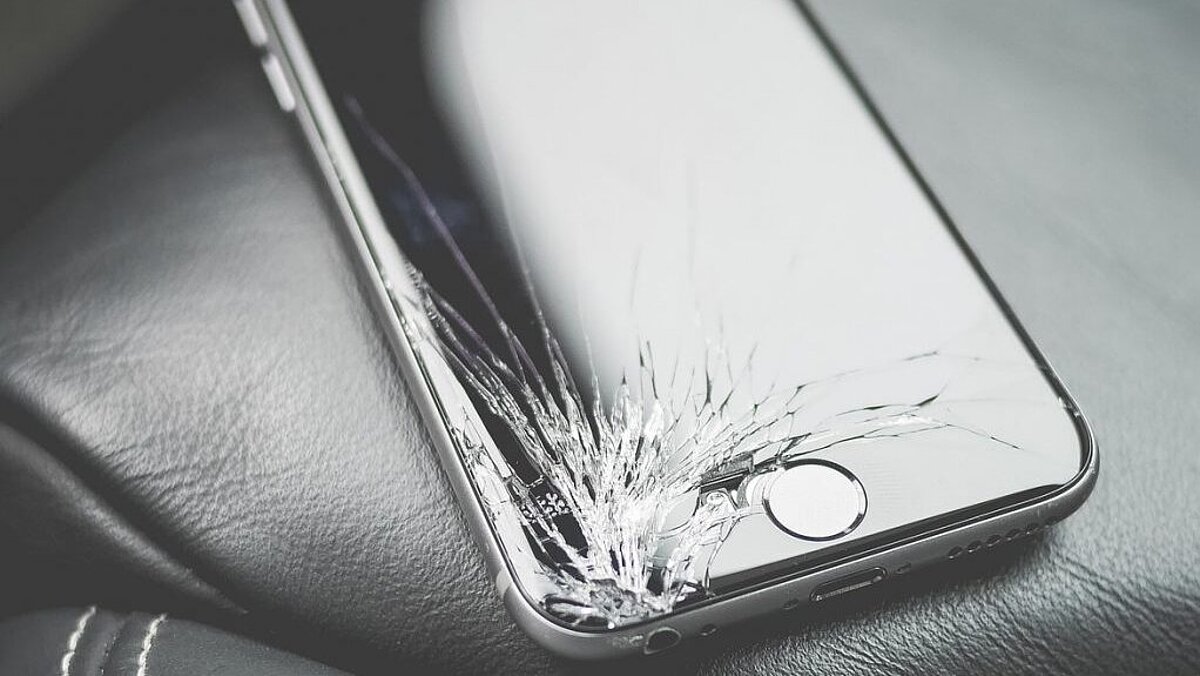Cracks after the fall: Why smartphone displays break only sometimes.

We all know the emotional shock when the smartphone slips out of your hand and hits the hard floor in what feels like slow motion. You hardly dare to look at it because you fear that the familiar spider pattern is smiling at you. Another €100 or more that has vanished into thin air.
Sometimes, however, you are lucky, although it can hardly be that nothing has happened.
But how is it possible that the display doesn't always shatter into 1,000 pieces?
Let's take a more technical approach.
Fracture mechanics stress analysis of cracks in engineering structures using the FEM.
High-strength materials under extreme operating conditions
It is not only in aerospace or Formula 1 that materials have to withstand very high stresses. Production tools have to be harder, stiffer and more wear-resistant than the components they are used to machine. Even your smartphone display probably has an extremely high-strength glass if it has survived falls unscathed so far.
The high strength and wear resistance comes at the price of the fact that the materials used show practically no plastic deformation before they fail in the event of overload due to violent fracture or fatigue. In general, the higher the yield point and strength, the more brittle a material behaves. The brittleness of most materials also increases with decreasing temperature.
Due to the manufacturing process, every real construction material has flaws (pores, blowholes, inclusions) or microscopic incipient cracks occur as a result of operational stresses. Especially in the case of brittle materials, these unavoidable crack-like defects can develop into macroscopic cracks and are the decisive cause of failure due to force or fatigue fracture. The evaluation of structures with fracture mechanics concepts then provides a higher degree of reliability than the classical strength calculation.
In addition to high-strength steels, cast iron and some metallic alloys, brittle failing structural materials include ceramic materials such as aluminum oxide, zirconium oxide or silicon nitride. The compressive strength of these engineering ceramic materials is several thousand megapascals, exceeding the strength of most metallic materials. Moreover, they can still perform their function at temperatures exceeding 1000°C and under the influence of aggressive media without corroding or creeping. Higher-strength plastics and fiber-reinforced plastics, which are used in lightweight construction primarily because of their low specific weight, should also not be forgotten.
Damage tolerant design of structures
The starting point of failure is often microscopic defects in the form of pores or cracks, which are not visible from the outside but can grow stably or unstably as a result of component stress. Thus, in the case of crack growth, even the smallest defects or cracks in components cause damage to the structure that eventually leads to failure.
It is probably surprising to many engineers in design that a component does not always fail at the point or under the load where the greatest stress was determined in the design phase, but rather seemingly safe areas of the component cannot withstand the operational loads. This process of recognition does not begin until the failure has occurred. By means of a fracture mechanics evaluation, such cases of damage can be avoided in advance. Even if the damage has already occurred and performing a detailed stress analysis with the FEM cannot sufficiently explain the damage, a fracture mechanics stress analysis offers the possibility to design the structure more safely against force or fatigue fracture.
In aerospace engineering, load-bearing structures have been designed to be damage-tolerant for some time. This means that cracks in the structure of an aircraft are generally permissible as long as their propagation is only subcritical under the given operational loads. Modern fracture mechanics calculation methods based on the FEM are suitable tools for determining the stress at the crack tip, even for complex crack configurations. They are the basis for the evaluation and prediction of crack propagation and fracture processes. Thanks to fracture-mechanical design with numerical calculation methods and regular inspection for cracks with non-destructive testing methods, cracked structures are very safe today.
Fracture mechanics analysis of cracked structures
The fracture mechanics evaluation of crack-like defects plays an increasingly important role for the safety, service life and reliability of technical designs. In order to calculate the stress situation at cracks, FEM analyses are being used to an increasing extent even in areas where previously the component reliability could only be proven with complex and expensive test series. Knowledge of crack stress can be used to estimate the reduced strength of a component under static loading, as well as the remaining life of a component under cyclic fatigue loading. Many calculation engineers shy away from performing fracture mechanics calculations themselves due to the higher calculation effort and their insufficient knowledge of fracture mechanics. Merkle & Partner can support you in this.
Basically, a distinction can be made between linear-elastic fracture mechanics (LEBM) and elastic-plastic fracture mechanics (EPBM). LEBM is the appropriate tool for glass and ceramic materials as well as cracks in metallic materials and plastics where the plastically deformed zone at the crack tip is significantly smaller than the crack size. In addition to elastic material behavior, the EPBM also takes into account the influence of plastic deformation in the crack tip region. It should be used when a visible plastic deformation is formed at the crack tip. In LEBM, the K concept is applied, where the crack stress is described by the stress intensity factors KI, KII and KIII (Figure 1). In EPBM, the older experimentally based crack tip opening displacement (CTOD) concept and the more modern physically based J-integral concept are applied. The J-integral evaluates the stress and distortion state along a path around the crack tip and is very well suited for calculation with the FEM (Figure 2).
Carrying out a fracture mechanics FEM calculation
Special meshing techniques are used to efficiently calculate the stress at the crack tip. Similar to a spider web, a focused mesh with progressively smaller elements is placed around the crack tip in the direction of the crack tip. Special crack tip elements are used directly at the crack tip, which can reproduce the singularity of stresses and deformations at the crack tip more accurately than the usual finite element types.
Because meshing structures with cracks is much more costly than FE analysis without cracks, the effort can be limited, especially for large models, by using a submodel technique. To do this, a block is cut out at the location of the crack to be modeled in the case of solid models (a rectangle in the case of shell models) and the crack is meshed separately. Subsequently, the meshed block can be reinserted into the global model with an exact fit and the different meshes can be tightly connected via tie constraints (Figure 1). However, it is also possible to apply the sectional stresses from the FE stress analysis without crack as boundary conditions to the cut-out volume with crack and perform the fracture mechanics FE analysis on this submodel. In this way, the local crack stress can be determined very efficiently even after a stress analysis has been performed. In addition, the submodel technique can be used to investigate different crack lengths and crack orientations, whereby the stress on the overall structure is calculated only once. This approach is particularly suitable for brittle materials such as ceramics and glass or metallic materials with small cracks compared to the component dimensions, which do not affect the overall stiffness of the structure.
After the FEM calculation of the fracture-mechanical stress quantities K or J, these must be compared with known material parameters in order to perform a fracture-mechanical verification. Often, the aim of a fracture mechanics analysis is also to determine the critical crack length at a given load, to predict the ultimate load or to determine the required toughness for material selection.
*** Translated with www.DeepL.com/Translator (free version) ***
![[Translate to English:] Linearelastische FE-Simulation eines halbelliptischen Oberflächenrisses in einem keramischen Bauteil unter Biegebelastung. Linear elastic FE simulation of a semi-elliptical surface crack in a ceramic component under bending load.](/fileadmin/_processed_/5/2/csm_ABBILD1-300x180_1887d0e531.png)
If you've made it this far, you seem to be really interested in this topic.
We would be happy to provide you with non-binding information on how you too can use simulation to avoid expensive damage to your products. Please do not hesitate to contact us.
Your Stefan Merkle

![[Translate to English:] Smartphone-Display nach dem Sturz Smartphone-Display nach dem Sturz](/fileadmin/_processed_/e/4/csm_Bruchmechanische-Beanspruchungsanalyse-von-Rissen-in-technischen-Strukturen-mit-der-FEM-1-768x554_98230eae98.jpg)
![[Translate to English:] Elastisch-Plastische FE-Simulation eines Versuchs zur Bestimmung der Rissbruchzähigkeit von Stahl. Elastic-plastic FE simulation of a test to determine the crack fracture toughness of steel.](/fileadmin/_processed_/0/6/csm_ABBILD2-300x243_47f7417590.png)